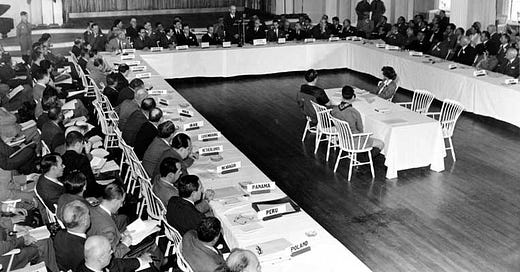What We Can Learn From The 1944 UN Monetary and Financial Conference
Held in Bretton Woods, New Hampshire, this historic "Meeting of the Minds" can teach us how to create lasting change in our own company and community.
In 1944, about 730 delegates from 44 countries attended the United Nations Monetary and Financial Conference in Bretton Woods, New Hampshire.
There, the United States and its allies during WWII devised an Agreement and a System for international monetary policy, trade, and economic growth that lasted almost 30 years until President Nixon took the US Dollar off the Gold Standard.
As we discuss how to develop lasting change in your company, which should be the goal of most strategic team meetings or executive offsites you hold with leaders in your company, this “Bretton Woods Moment” serves as one example for how to establish and leverage a Meeting of the Minds in your own world.
U.N. Monetary Conference (Photo: Associated Press; Abe Fox)
The 1944 UN Monetary Conference was successful in breaking economic barriers between some of the world’s most powerful countries (despite being in the middle of WWII) because there existed…
a clear purpose for the meeting,
“pre-work” from a diverse range of experts,
urgency that inspired unusual collaboration,
follow-up to hold invested parties accountable,
and the ratification of systems that are still in-place today.
Today, the “systems” designed from that conference, which are the International Monetary Fund and the World Bank, still exist even though we’ve been off the gold standard since the early 1970s.
Establish A Clear Purpose For Your Meetings
Heading into the United Nations Monetary and Financial Conference, all stakeholders understood the agenda for this Meeting of the Minds.
They desired to create a new international economic system to keep member countries out of future wars, increase economic growth opportunities, and avoid global shocks such as the Great Depression in the 1930s for which the world was only starting to recover from fully by the mid 1940s.
While this purpose wasn’t simple, it was clear.
And, with a clear purpose, there was a greater chance of success.
Thankfully, we don’t need to get 730 delegates on the same page about the outcome of our quarterly executive offsites or annual strategy sessions.
Likely, you have a small team of individuals who run your company, so if you’re able to define clear goals for your own internal Meetings of the Minds, you’re much more likely to solve pressing problems, capitalize on exciting new opportunities, and create lasting change.
With a clear purpose, you can communicate the common goal with meeting attendees so all your stakeholders or team members are onboard with the plan.
“Pre-Work” With Help From A Diverse Set of Experts
Preparation for this summit began as early as 1942 for many stakeholders.
Financial experts from most of the leading countries held internal, bilateral, and multilateral meetings before the conference to create an agreement and systems that a vast majority of stakeholders would commit to enacting long-term.
The United States, for example, sought input from the Treasury Department, Federal Reserve, and representation for the country to the United Nations.
Harry Dexter, perhaps the leading American voice during the conference as a senior adviser to the US Secretary of the Treasury, also consulted British Treasury Adviser and renowned economist John Maynard Keynes as the two evolved into the primary designers of the Bretton Wood Systems.
And thus, when these delegates met in 1944, they ultimately agreed to create the International Monetary Foundation as well as the World Bank.
For us, the more important the outcome is for our company, the greater amount of diversity we should employ from subject matter experts who can help us prepare for game-time decision-making that will have long-term ramifications.
Create (or Identify) Urgency
After the Great Depression, many of the countries attending the 1944 UN Monetary and Financial Conference wished to avoid the same economic downfall which arguably precipitated WWII.
No one wanted another World War in the 1940s, and so finding common ground as a result of the conference was a MUST.
By agreeing to meet in Bretton Woods, New Hampshire, members of the United Nations created additional urgency by committing to specific dates on the calendar by which all the “pre-work” was to-be-completed and decisions were going to be made.
By committing your team, advisors, and other stakeholders to given dates for your “Meetings of the Minds”, you will also create leverageable urgency (provided you’ve set a clear purpose for strategizing and all parties have done their '“pre-work” before the meeting starts).
Urgency inspires action.
Hold Yourself and Others Accountable To Their Commitments
After the UN Monetary and Financial Conference concluded in 1944, they took action and signed the Articles of Agreement for the International Monetary Foundation in December 1945.
This organization, as well as the World Bank (which also formed as a result of the Bretton Woods Agreement), still exist today even though the gold standard disintegrated in the 1970s, and now almost every major country on earth is a member of both organizations.
Had the member organizations focused more on WWII, or their own domestic monetary policy, or some other priorities, then these institutions may not have been formed despite the productive 1944 Bretton Woods conference.
And without the IMF or World Bank, would we have started another World War by now? Would we enjoy such prosperous global economies where our daily standards of life are eons better than what those in the 1940s enjoyed?
Who knows…
The good news is that…
If you are clear with your purpose, do the “pre-work”, and create (or identify) urgency, then you will feel more accountable to your team members and they will feel more committed to following up after your meeting(s).
Put Systems In Place For Scale
The IMF and World Bank are now massive organizations managing hundreds of billions of dollars and playing central roles in economic stability across the world’s most powerful nations.
If the “Bretton Woods Moment” had the clear purposes of preventing future world wars, increasing economic growth opportunities, and avoiding global shocks such as the Great Depression, then it’s because of the IMF and World Bank that these goals have largely been met.
In order to avoid going backwards, we must convert the purpose, “pre-work”, urgency, and follow-up of our Meetings of the Minds into systems that scale.
For a growing small business, this may mean identifying your Ideal Clients and then building scalable marketing systems to consistently attract new prospects.
Another system could be tools for hiring and engaging your team members so that only the world’s best and brightest work for your company, and all your employees spend as much time as possible working in their Zone of Genius.
Systems allow you to scale your efforts and “lock in” benefits of your group’s collective intelligence for months, years, or even decades into the future!
After you solve a pressing problem, your work is not done. Create a system so you never have to deal with that issue again, and/or so the opportunities you seek can continue benefitting your organization for decades to come.
How can you create lasting changes that could lead to purpose, profits, and potential growth for years to come?
Hopefully Bretton Woods inspires your own “Meeting of the Minds” within your company, industry, or community.
We all have important work to do, so while today we may not be creating international monetary policies or preventing world wars, don’t shortchange the possibilities that may arise from your team’s ideas and actions.
Give yourself and your team(s) purpose, “pre-work” prompts, urgency, follow-up tasks, and systems so you can continue to assist you in truly changing the world.
Stay safe and shoot me a reply email or comment below if you enjoyed this write-up!
-Jared
P.S. - this is a free weekly edition of our newsletter. Each week, we cover practical insights and resources on marketing, sales, personal branding, community-building, and other building blocks for scaling a profitable bootstrapped business.
If you’re not a paid subscriber, here’s what you’re missing…
21 Marketing Channels To "Experiment" With To Find More Ideal Clients
A 194 page playbook from one of Silicon Valley’s top CEO coaches
PLUS, we are releasing “How To Build A World-Class Network In Record Time” as an eBook and updated/expanded version of our online course under the same name in a few short weeks!!!
That alone is a $400+ value, included in your monthly or annual subscription to premium versions of this newsletter.
To receive ALL of our content, including “How To Build A World-Class Network In Record Time” and our most valuable emails each Friday, upgrade your subscription by clicking below.
Jared Kleinert is the founder of Meeting of the Minds (motm.co), as well as a TED speaker, 2x award-winning author, and USA Today's "Most Connected Millennial".
Meeting of the Minds curates "super-connectors" and subject matter experts as invite-only attendees to 3 day summits in places like Napa Valley, Bermuda, and elsewhere, as well as “deep dives” such as this Marketing and Biz Dev strategy & implementation workshop. Members of the MOTM network include CEOs of 7, 8, and 9-figure businesses, creators of globally-recognized brands and social movements, New York Times bestselling authors, founders of pre-IPO tech unicorns, c-suite execs from Fortune 500 companies, and others.
Jared's career began at 15 years old when he started his first company, and took off at 16 while working as the first intern, and then one of the first 10 employees, for an enterprise SaaS company called 15Five, which today has raised over $40M and has almost 2000 forward-thinking companies as monthly recurring clients.
Later, Jared would become a delegate to President Obama's 2013 Global Entrepreneurship Summit in Malaysia, write multiple books including the "#1 Entrepreneurship Book of 2015", and speak at TED@IBM the day before he turned 20.
As a highly-sought after keynote speaker and consultant, Jared’s clients range from organizations like Facebook, Samsung, Bacardi, Estee Lauder, IBM, Cornell, Berkeley, AdAge, and the National Speakers Association. His insights on entrepreneurship, networking, marketing, and business development have been featured in Forbes, TIME, Harvard Business Review, Fortune, NPR, Entrepreneur, Mashable, Fox Business and more.
Don’t forget to share! :)






